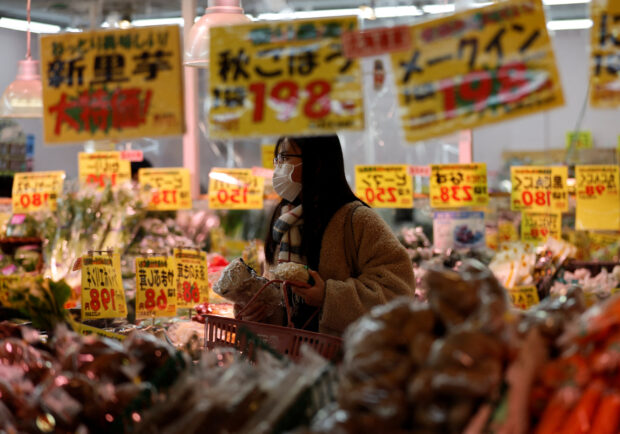
A shopper is reflected on a mirror glass as she checks food items at a supermarket in Tokyo, Japan January 20, 2023. REUTERS/Issei Kato/File photo
TOKYO -Japan’s wholesale inflation was flat in December from a year earlier, slowing for the 12th consecutive month, underscoring the central bank’s view that cost-push pressure from rising raw material prices will steadily dissipate.
The data indicate that rises in consumer inflation will moderate in coming months, and take pressure off the Bank of Japan (BOJ) to phase out its massive monetary stimulus soon.
The reading for the corporate goods price index (CGPI), which measures the prices companies charge each other for their goods and services, compared with a median market forecast for a 0.3-percent fall and followed a 0.3-percent increase in November.
The result was the lowest since a 0.9-percent drop in February 2021, showed BOJ data released on Tuesday.
The slowdown in wholesale prices was due partly to government subsidies to curb petrol and utility bills, which combined shaved 0.9 percent point off wholesale inflation, a BOJ official told a briefing.
READ: Japan wholesale inflation slowed sharply in Nov on easing cost pressure
Prices of steel, chemical and wood products also fell in December, a sign that weakening global demand for some commodities was pushing down raw material costs for companies.
But about 80 percent of items in the index saw prices rise from year-before levels, underscoring broadening inflationary pressure that may help the BOJ hit its 2 percent inflation target.
The wholesale price data, considered a leading indicator of consumer inflation, is among factors the BOJ scrutinizes in gauging broader price trends and deciding on the timing of exiting ultra-loose monetary policy.
READ: BOJ keeps ultra-loose policy intact
At next week’s interest rate review, the BOJ will likely cut its core consumer inflation forecast for fiscal 2024, but broadly maintain its view that trend inflation will stay near its 2 percent target in coming months, sources have told Reuters.
BOJ Governor Kazuo Ueda has stressed the need to keep monetary policy ultra-loose until the recent cost-driven price rises shift into inflation driven more by robust domestic demand accompanied by higher wages.

